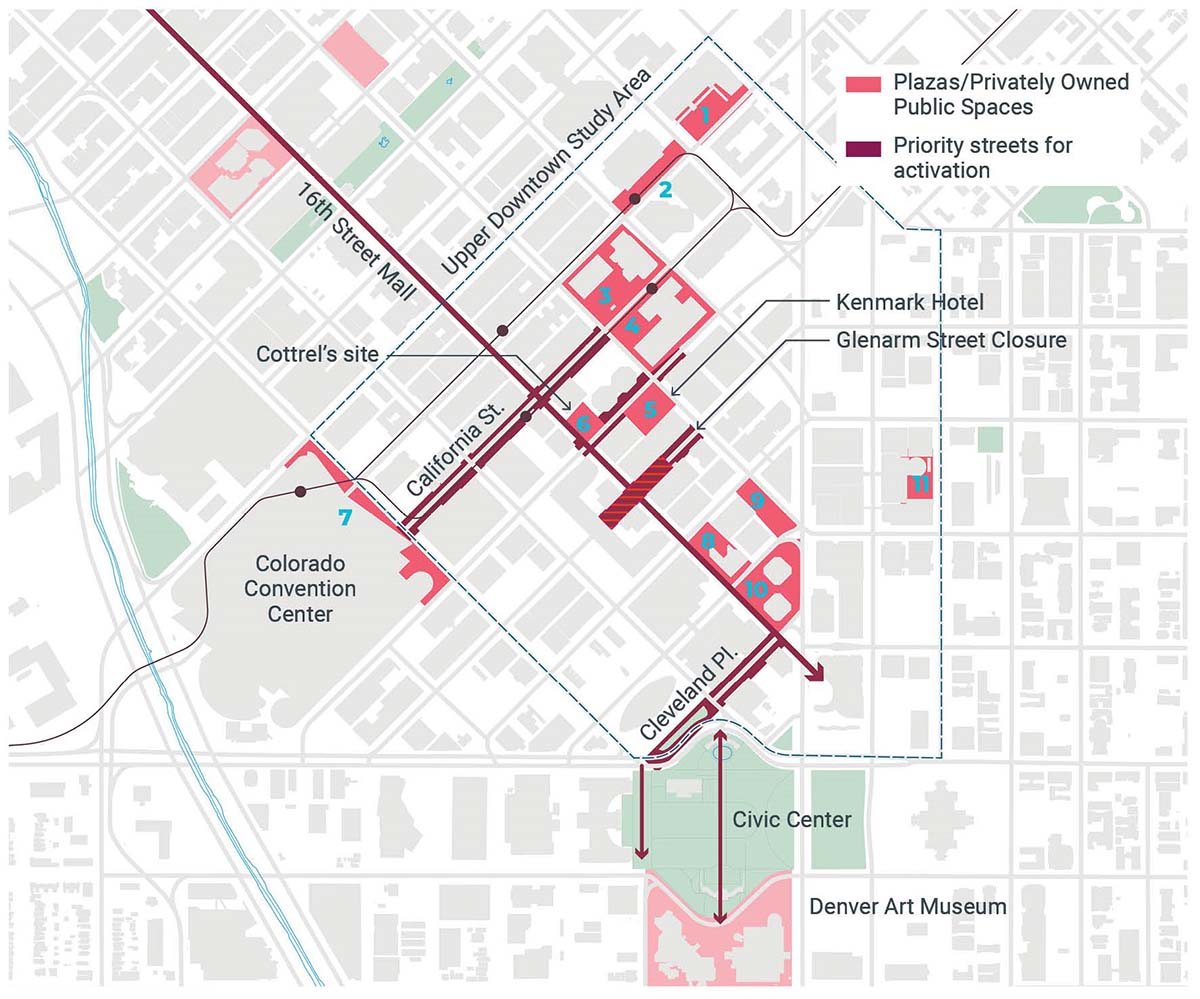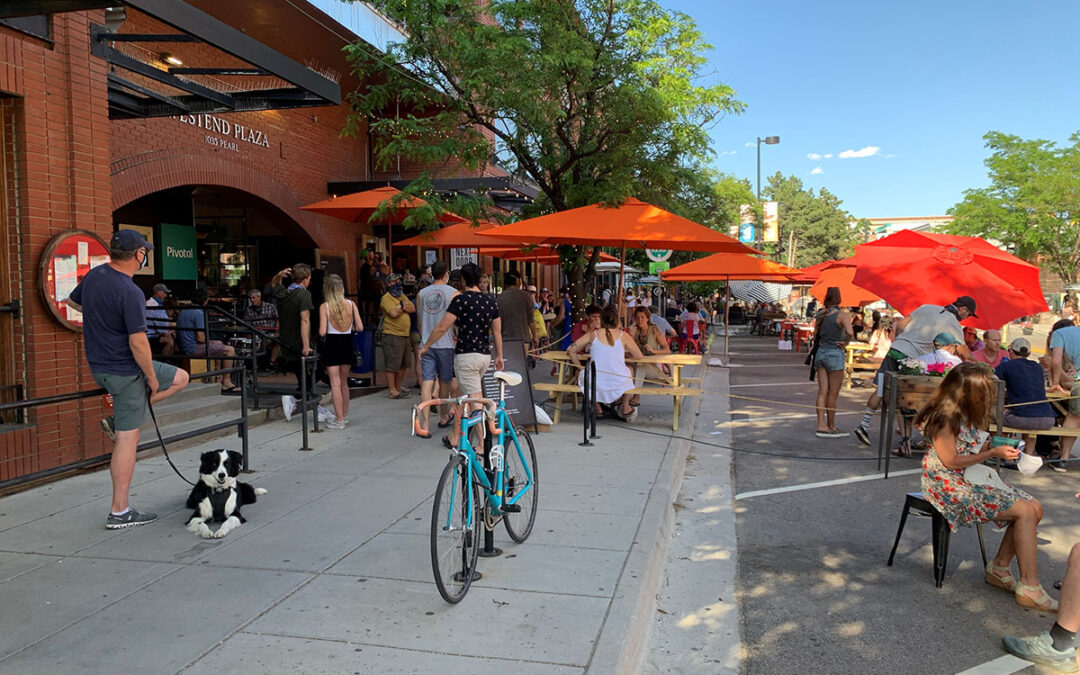The pandemic has instigated a shift in thinking about public spaces in our cities. Out of necessity for health, safety, and Last week, two articles in the Denver Post and Denver Business Journal examined the future for Downtown Denver and the challenges borne by the pandemic. The impacts the past year has had on retail, restaurants, and office space are well known, and around the country there has been reams of speculation written about the future of cities and downtowns.
The optimism expressed by the Post and DBJ delivers an important message. The investments made over the past decades put downtown on a strong foundation, and over time the area will recover. But the economic shock to retail and office uses was substantial and we cannot take that future for granted. As the Post reported, “the city’s office market has taken a beating during the pandemic. Office space available for sublease shot up by 86% during the pandemic, reaching 4.7 million square feet by the end of 2020, according to CBRE research.”
As employers reconsider their workspaces, it remains to be seen if more fundamental shifts emerge in the downtown market. This reinforces the importance of continuing to evolve downtown into a mixed-use neighborhood. Increasing and diversifying the residential population has been at the heart of downtown’s revival and is essential to its future vibrancy and resiliency. It is understandable that the focus of these articles is on long-term goals and development trends. But we think this overlooks an essential aspect to recovering and expanding the prosperity of downtown—the public realm.
Great cities are ultimately places for people. They are energized by a vibrant and diverse public life that occurs in their streets, squares, and parks. Great places attract talent, employers and investment, and cities that are devoted to their public realm have seen profound returns on that effort, including Denver. And Denver is currently planning transformative public realm projects that will reshape downtown in the years to come. Our team at Livable Cities Studio has been fortunate to be involved with the Outdoor Downtown Plan, Denver Moves Downtown, and the 16th Street Mall redevelopment (previous experience of Matt Shawaker at Stantec), as well as our current work with Denver Parks and Recreation, DOTI and Wenk Associates to revitalize Civic Center. The policies and projects proposed in these plans will create new public spaces, multiply mobility options, and grow public life throughout downtown. These are substantial investments, but they are essential to expanding prosperity, resilience, and equity in our city.

Large projects are complex and take years to implement, and the current situation requires more responsive solutions. As DBJ reported, many office leaders are still waiting for more clarity on the pandemic before they make long-term decisions about their space. These decisions are happening now; the experience in downtown today will reverberate for years. Creative activation of the public realm is needed more than ever to support the health and vibrancy of downtown and set the stage for longer term ambitions.
There are multiple opportunities to do this, but none as promising as the privately owned public spaces – you know, those plazas at the base of office towers which are spread throughout downtown. They are a focus of the Downtown Denver Partnership’s Upper Downtown Plan, which identifies ten existing and potential plazas within the old “central business district.” Activation of these spaces can transform the public life of downtown and create new amenities for tenants that address their specific needs as employees return to the office.

The potential of privately owned public spaces (aka. “POPS”) is well known in cities throughout the country. In New York there are over 590 POPS, contributing over 3.8 million square feet of public space to the city – the equivalent of nine Bryant Parks. This includes spaces like Paley Park, a renown ‘pocket park’ in midtown Manhattan, which the Project for Public Spaces recognizes as one of the world’s great public spaces. More recently, the Independence Beer Garden in Philadelphia demonstrates how creative activation can transform a utilitarian office building into the best happy hour spot in the city.

Paley Park and the New York POPS show us how to do it. Provide diverse seating, sun and shade, visibility, water and food -the basics that William Whyte taught us. Independence Beer Garden demonstrates new, flexible ways to provide these elements. Simple furnishings, planters and paint can be deployed to quickly change a space. As can be seen in Austin or Portland, kiosks and food trucks can quickly transform a plaza – or street – into a vibrant marketplace, simultaneously expanding public life and providing a conduit for small businesses to access the downtown market and enabling a more equitable and authentic city.

Fortunately, we already know this works in Denver too. Street closures at Larimer and Glenarm, and expanded patios throughout the city have shown the power of simple public realm investments to create a lively, magnetic place. All that is required is the will to question the status quo, and the urgency to act. This past summer our collective urgency inspired a wave of creativity that undoubtedly saved many jobs. It also showed the way for the future. As vaccines provide a light at the end of the tunnel this spring and summer, let us not lose that sense of urgency. Downtown is not perfect, but it is still the economic and cultural core of our city. Let us expand our commitment to its public realm and not just restore downtown, but make it more dynamic, equitable and magnetic than ever.

